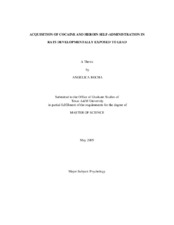| dc.description.abstract | Rationale: The rate of acquisition of drug self-administration may serve as a predictor of later drug-taking behavior, possibly influencing vulnerability to initiate drug use. Objectives: The present study examined the effects of perinatal (gestation/lactation) lead exposure on adult rates of acquisition of intravenous (i.v.) heroin self-administration and cocaine self-administration using an automated procedure that included both Pavlovian and operant components. Methods: For Experiment 1, female rats were gavaged daily with 0 or 16 mg lead for 30 days prior to breeding with nonexposed males. Metal administration continued through pregnancy and lactation and was discontinued at weaning (postnatal day [PND] 21). Animals born to control or lead-exposed dams received indwelling jugular catheters as adults and subsequently were tested daily in a preparation where sessions included an initial 3-hr autoshaping period followed by a 3- hr self-administration period. During autoshaping, heroin (.018 mg/kg) infusions were paired with the extension and retraction of a lever when a lever press was not made for 15 sec, while infusions occurred during self-administration only when a lever press was executed (FR-1). The criterion for acquisition was a 2-day period during which a mean of 10 infusions/session occurred during self-administration. Animals were given 35 days to reach criterion. Results: Findings from Experiment 1 showed the proportion of rats meeting the lever-press response criterion for heroin when tested as adults was lower among lead-exposed animals. In Experiment 2, cocaine (.20 mg/kg) was presented to animals that underwent the same metal-exposure regimen, surgical procedures and methods with variations only in the number of infusions that were automatically administered during the Pavlovian component. Criterion for cocaine acquisition was a mean of 50 infusions over a two-day. In Experiment 2, a greater proportion of leadexposed animals reached the criterion for cocaine acquisition. Conclusions: Developmentally lead-exposed animals showed a decrease in vulnerability to initiate drug-taking behavior when presented with heroin in the adult phase, relative to controls. In contrast, developmentally lead-exposed animals showed an enhanced vulnerability to reach the criterion for cocaine self-administration. Clinical relevance of developmental exposure to lead and the attendant vulnerability to self-administer drugs of abuse is discussed. | en |


